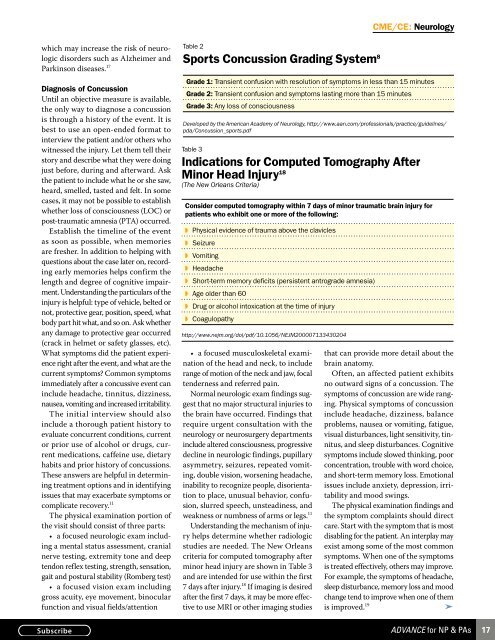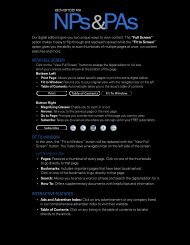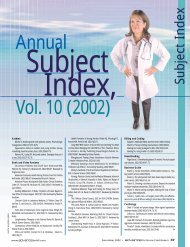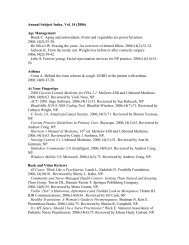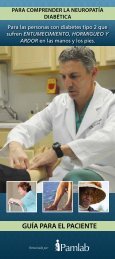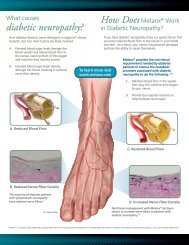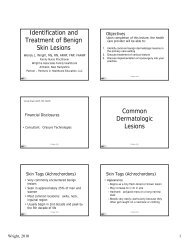View Full Screen - ADVANCE for NPs & PAs
View Full Screen - ADVANCE for NPs & PAs
View Full Screen - ADVANCE for NPs & PAs
Create successful ePaper yourself
Turn your PDF publications into a flip-book with our unique Google optimized e-Paper software.
CME/CE: Neurology<br />
which may increase the risk of neurologic<br />
disorders such as Alzheimer and<br />
Parkinson diseases. 17<br />
Diagnosis of Concussion<br />
Until an objective measure is available,<br />
the only way to diagnose a concussion<br />
is through a history of the event. It is<br />
best to use an open-ended <strong>for</strong>mat to<br />
interview the patient and/or others who<br />
witnessed the injury. Let them tell their<br />
story and describe what they were doing<br />
just be<strong>for</strong>e, during and afterward. Ask<br />
the patient to include what he or she saw,<br />
heard, smelled, tasted and felt. In some<br />
cases, it may not be possible to establish<br />
whether loss of consciousness (LOC) or<br />
post-traumatic amnesia (PTA) occurred.<br />
Establish the timeline of the event<br />
as soon as possible, when memories<br />
are fresher. In addition to helping with<br />
questions about the case later on, recording<br />
early memories helps confirm the<br />
length and degree of cognitive impairment.<br />
Understanding the particulars of the<br />
injury is helpful: type of vehicle, belted or<br />
not, protective gear, position, speed, what<br />
body part hit what, and so on. Ask whether<br />
any damage to protective gear occurred<br />
(crack in helmet or safety glasses, etc).<br />
What symptoms did the patient experience<br />
right after the event, and what are the<br />
current symptoms Common symptoms<br />
immediately after a concussive event can<br />
include headache, tinnitus, dizziness,<br />
nausea, vomiting and increased irritability.<br />
The initial interview should also<br />
include a thorough patient history to<br />
evaluate concurrent conditions, current<br />
or prior use of alcohol or drugs, current<br />
medications, caffeine use, dietary<br />
habits and prior history of concussions.<br />
These answers are helpful in determining<br />
treatment options and in identifying<br />
issues that may exacerbate symptoms or<br />
complicate recovery. 11<br />
The physical examination portion of<br />
the visit should consist of three parts:<br />
• a focused neurologic exam including<br />
a mental status assessment, cranial<br />
nerve testing, extremity tone and deep<br />
tendon reflex testing, strength, sensation,<br />
gait and postural stability (Romberg test)<br />
• a focused vision exam including<br />
gross acuity, eye movement, binocular<br />
function and visual fields/attention<br />
Table 2<br />
Sports Concussion Grading System 8<br />
Grade 1: Transient confusion with resolution of symptoms in less than 15 minutes<br />
Grade 2: Transient confusion and symptoms lasting more than 15 minutes<br />
Grade 3: Any loss of consciousness<br />
Developed by the American Academy of Neurology, http://www.aan.com/professionals/practice/guidelines/<br />
pda/Concussion_sports.pdf<br />
Table 3<br />
Indications <strong>for</strong> Computed Tomography After<br />
Minor Head Injury 18<br />
(The New Orleans Criteria)<br />
Consider computed tomography within 7 days of minor traumatic brain injury <strong>for</strong><br />
patients who exhibit one or more of the following:<br />
◗ Physical evidence of trauma above the clavicles<br />
◗ Seizure<br />
◗ Vomiting<br />
◗ Headache<br />
◗ Short-term memory deficits (persistent antrograde amnesia)<br />
◗ Age older than 60<br />
◗ Drug or alcohol intoxication at the time of injury<br />
◗ Coagulopathy<br />
http://www.nejm.org/doi/pdf/10.1056/NEJM200007133430204<br />
• a focused musculoskeletal examination<br />
of the head and neck, to include<br />
range of motion of the neck and jaw, focal<br />
tenderness and referred pain.<br />
Normal neurologic exam findings suggest<br />
that no major structural injuries to<br />
the brain have occurred. Findings that<br />
require urgent consultation with the<br />
neurology or neurosurgery departments<br />
include altered consciousness, progressive<br />
decline in neurologic findings, pupillary<br />
asymmetry, seizures, repeated vomiting,<br />
double vision, worsening headache,<br />
inability to recognize people, disorientation<br />
to place, unusual behavior, confusion,<br />
slurred speech, unsteadiness, and<br />
weakness or numbness of arms or legs. 11<br />
Understanding the mechanism of injury<br />
helps determine whether radiologic<br />
studies are needed. The New Orleans<br />
criteria <strong>for</strong> computed tomography after<br />
minor head injury are shown in Table 3<br />
and are intended <strong>for</strong> use within the first<br />
7 days after injury. 18 If imaging is desired<br />
after the first 7 days, it may be more effective<br />
to use MRI or other imaging studies<br />
that can provide more detail about the<br />
brain anatomy.<br />
Often, an affected patient exhibits<br />
no outward signs of a concussion. The<br />
symptoms of concussion are wide ranging.<br />
Physical symptoms of concussion<br />
include headache, dizziness, balance<br />
problems, nausea or vomiting, fatigue,<br />
visual disturbances, light sensitivity, tinnitus,<br />
and sleep disturbances. Cognitive<br />
symptoms include slowed thinking, poor<br />
concentration, trouble with word choice,<br />
and short-term memory loss. Emotional<br />
issues include anxiety, depression, irritability<br />
and mood swings.<br />
The physical examination findings and<br />
the symptom complaints should direct<br />
care. Start with the symptom that is most<br />
disabling <strong>for</strong> the patient. An interplay may<br />
exist among some of the most common<br />
symptoms. When one of the symptoms<br />
is treated effectively, others may improve.<br />
For example, the symptoms of headache,<br />
sleep disturbance, memory loss and mood<br />
change tend to improve when one of them<br />
is improved. 19<br />
➤<br />
<strong>ADVANCE</strong> <strong>for</strong> NP & <strong>PAs</strong><br />
17


